It’s Heavy, but It Has a Good Western Blade and a Cool Handle
The main idea behind the TC chef’s knife concept was to create something that feels thin but still has the toughness of a western style kitchen knife. It’s definitely tough, but I’m personally at odds with the way it feels. The handle on this is wide in a way that I’m not used to, but that can pretty easily be attributed to personal bias.
Cangshan has put a few elements into it that could be considered more Japanese (or French), but the overall purpose of the TC chef’s knife is geared toward western-style use. It has a mostly straight-backed blade with a thick spine, but the curved, almost-octagonal handle and the long, angled bolster put this knife into a fairly unique ergonomic category.
There’s no denying that it cuts and handles well enough to make Cangshan worth a look from, at the very least, serious home cooks.
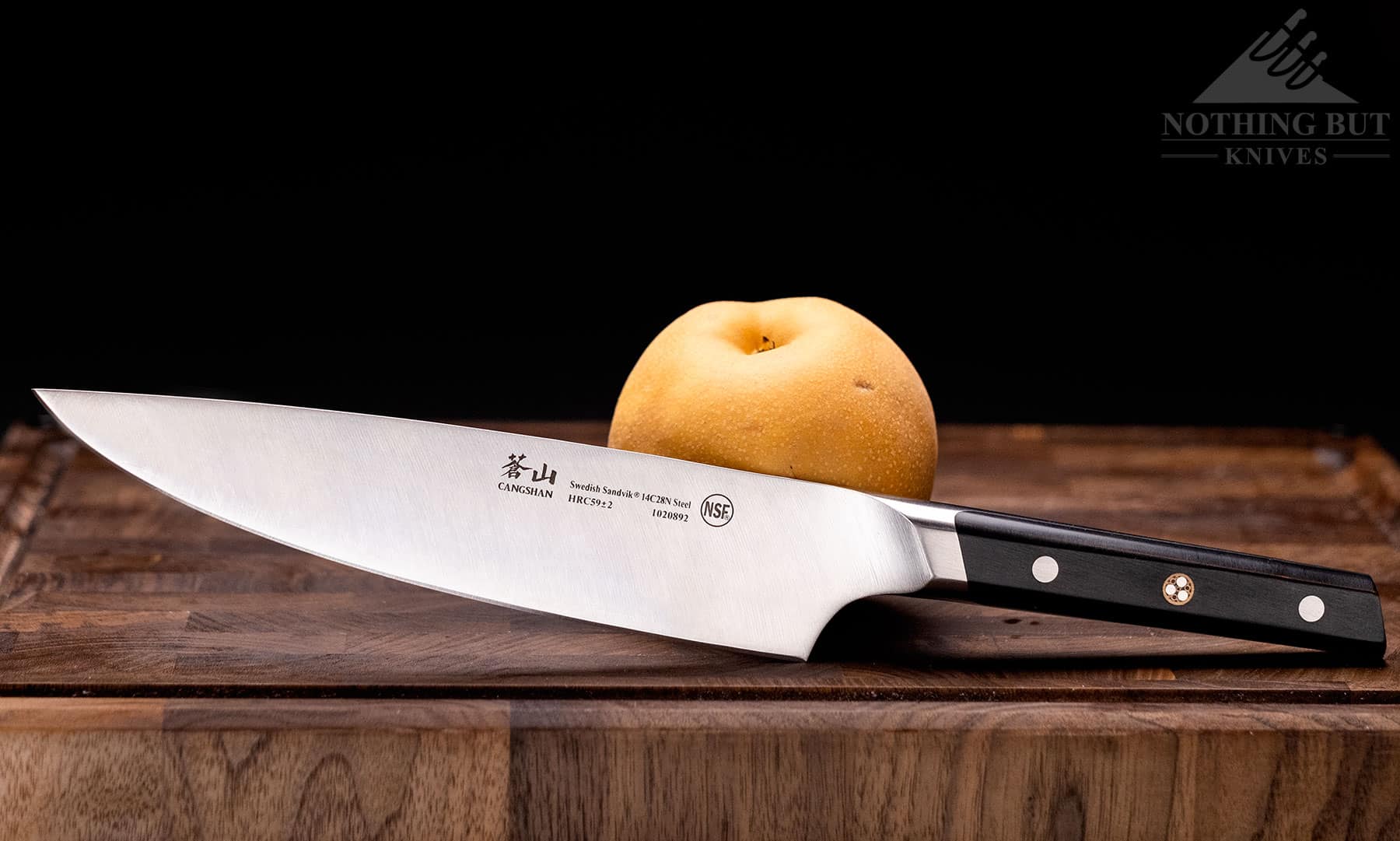
Specifications
| Overall Length: | 13.5” |
| Blade Length: | 8.0” |
| Blade Steel: | Sandvik 14C28N |
| Hardness: | 58 – 60 HRC |
| Blade Thickness: | 3 mm |
| Blade Shape: | Traditional Western Chef |
| Blade Grind: | Flat |
| Handle Length: | 5.5” |
| Handle Material: | Wood |
| Weight: | 9.14 oz |
Pros
| Angled bolster for pinch grip |
| Longer handle can provide some extra grip and leverage |
| Good balance just behind the bolster |
| Nice steel that can take a great edge |
Cons
| It’s on the heavier side |
| Thinner grind makes the edge fold over easier |
The Western Blade that kind of has a Japanese Edge
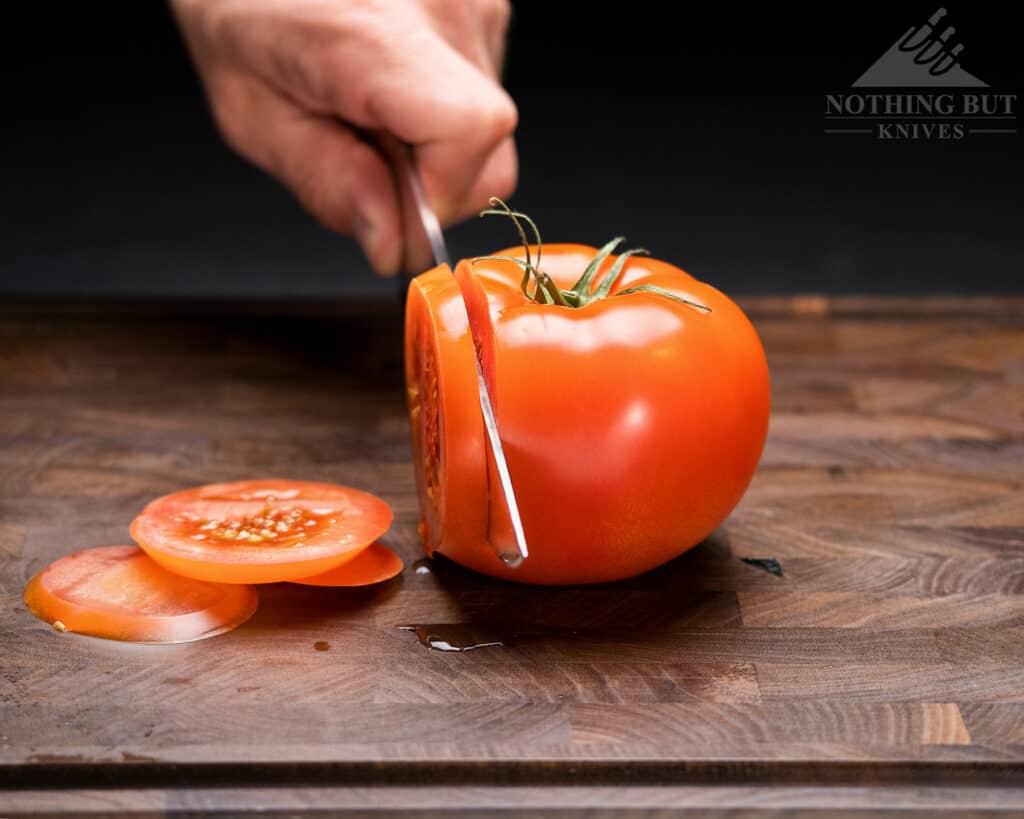
The edge is about on par with what I’d expect from a knife in this price range. It’s good but I wouldn’t call it outstandingly good. And while this is technically a western style blade in profile, the edge is almost as thin as most Japanese kitchen knives.
It’s ground to a 16-degree double bevel edge (like all Cangshan knives so far), but it still has a fairly thick spine, so it has a slicey action with a bit of wedging involved. It’s still sharp, and it cuts with a satisfying precision, but it has some of that thick-bladed German knife feeling.
In spite of the thick spine, I can get some pretty thin slices with this thing. In fact, the overall performance is pretty pleasant, so it seems like Cangshan did a good job on the grind here.
Good Steel but It’s More Tough than Hard
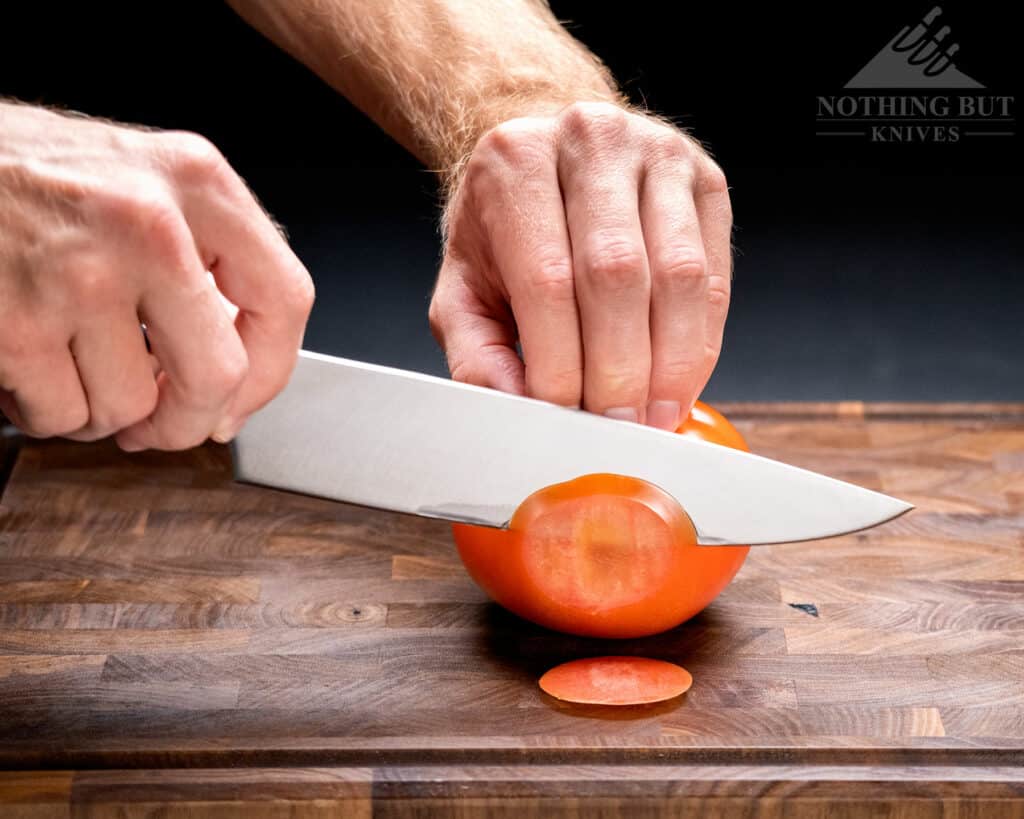
The steel is a little more interesting here, but I should warn you this section gets into the weeds a little bit. If the phrase “steel composition” makes your eyes glaze over you can happily skip down to the part where I unreasonably complain about, and then somewhat more reasonably praise, the handle. The TL;DR here is that the steel is really good but don’t expect great edge retention.
Sandvik 14C28N steel is the kind of thing you generally see in Swedish survival knives, and increasingly in EDC pocket knives. It’s a good budget steel that maintains a reasonably high level of toughness at higher HRc ratings, but the attraction of it has always been its ability to be sharpened thanks to the fine grain structure in the steel.
Cangshan pushes it as having a significantly better edge retention than the German steel they use in some of their other knives (X50Cr15MoV), and that might be true, but it creates the false impression that the Sandvik steel gives the TC chef’s knife amazing retention. The truth is that it will hold an edge for a while, but you should still be ready to get the sharpening stones out (or find a local sharpener) after a few months of regular use (I think Cangshan recommends 9 to 12 months of moderate use).
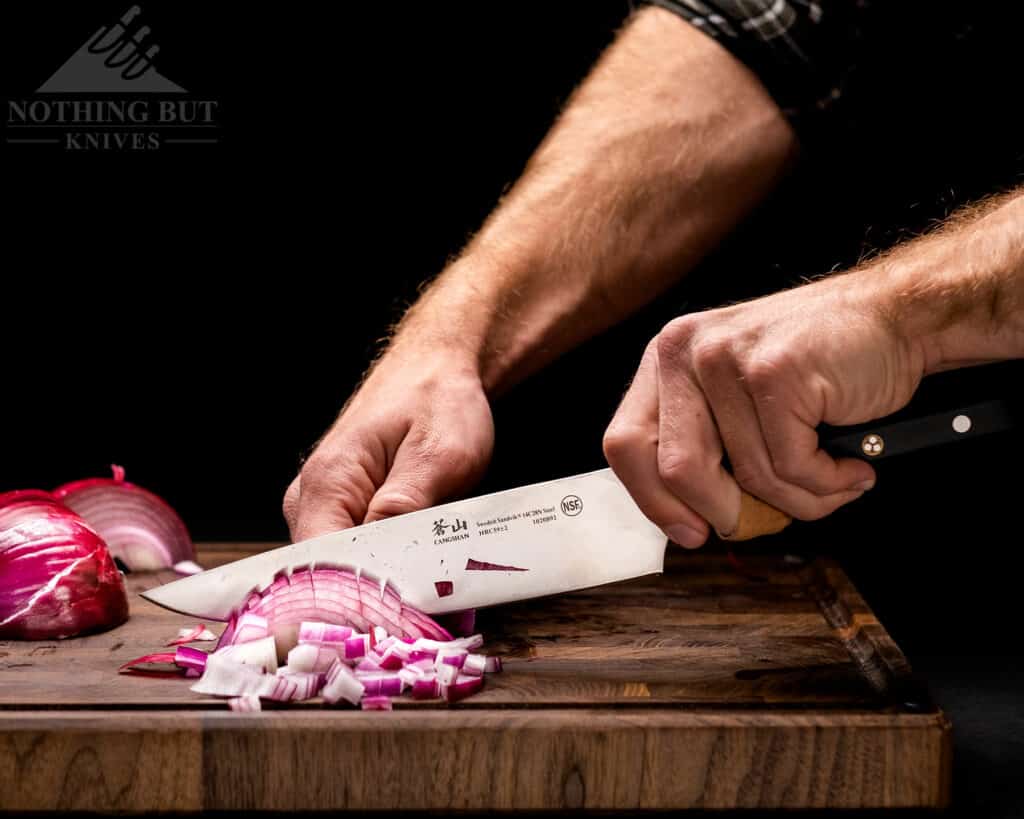
Most of the extra edge retention is probably coming more from the fact that Cangshan hardened the blade to around 60 HRc rather than the typical 56 to 58 that you’ll typically see in western style chef knives. I still started to feel a couple hiccups in the edge where I was using it most after about a week of moderate testing, but a honing rod can handle that just fine.
I really like 14C28N. It’s similar to AEB-L steel both in composition and in its toughness and corrosion resistance (although it’s a little bit better in that last category). I think both of them are great choices for kitchen knives because of that toughness and their ability to take crazy sharp edges, but I always feel the need to warn people about claims of “improved edge retention” because the expectation tends to be some kind of Excalibur-level wear resistance.
This is good steel, and Cangshan has actually done a decent job on the edge geometry. When this starts cutting a little rough, don’t cry about Chinese manufacturing practices; just give the edge a little love and care.
The Fancy Handle and My Fat Hand Ergonomics
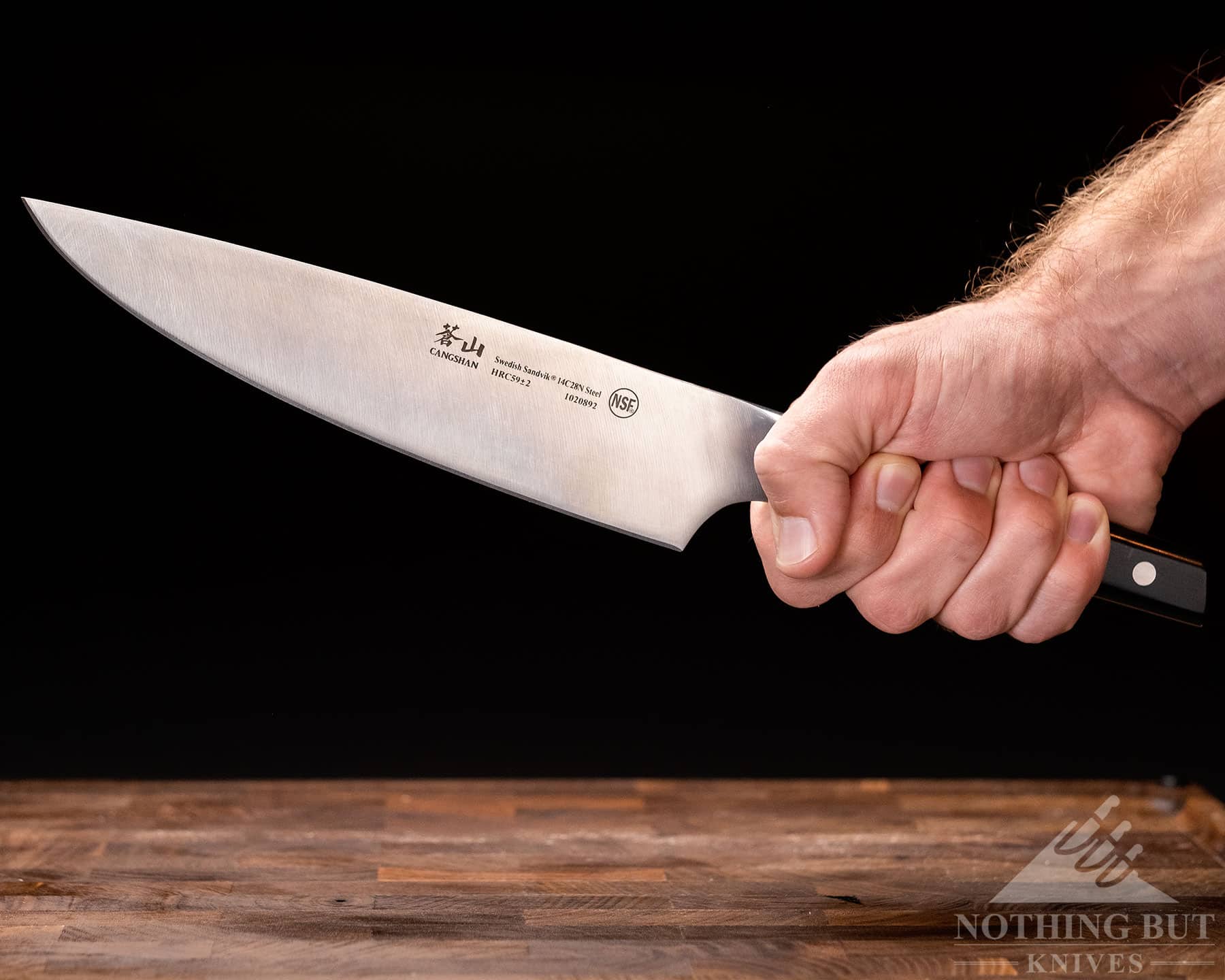
I don’t like this over thinner oval handles like what’s on the Yaxell Mon or my Mattia Borrani bowie chef’s knife. To me, the Cangshan TC just feels bulky in a pinch grip because I’ve gotten used to working with less material.
On the flip side, my wife loved the handle because the grip felt more secure, and the way it’s balanced makes it feel lighter. So it’s tricky to stick to criticism here. Fortunately there’s enough to talk about with this handle that I can just lay out the facts.
The Balance and the Weirdly Tapered Tang
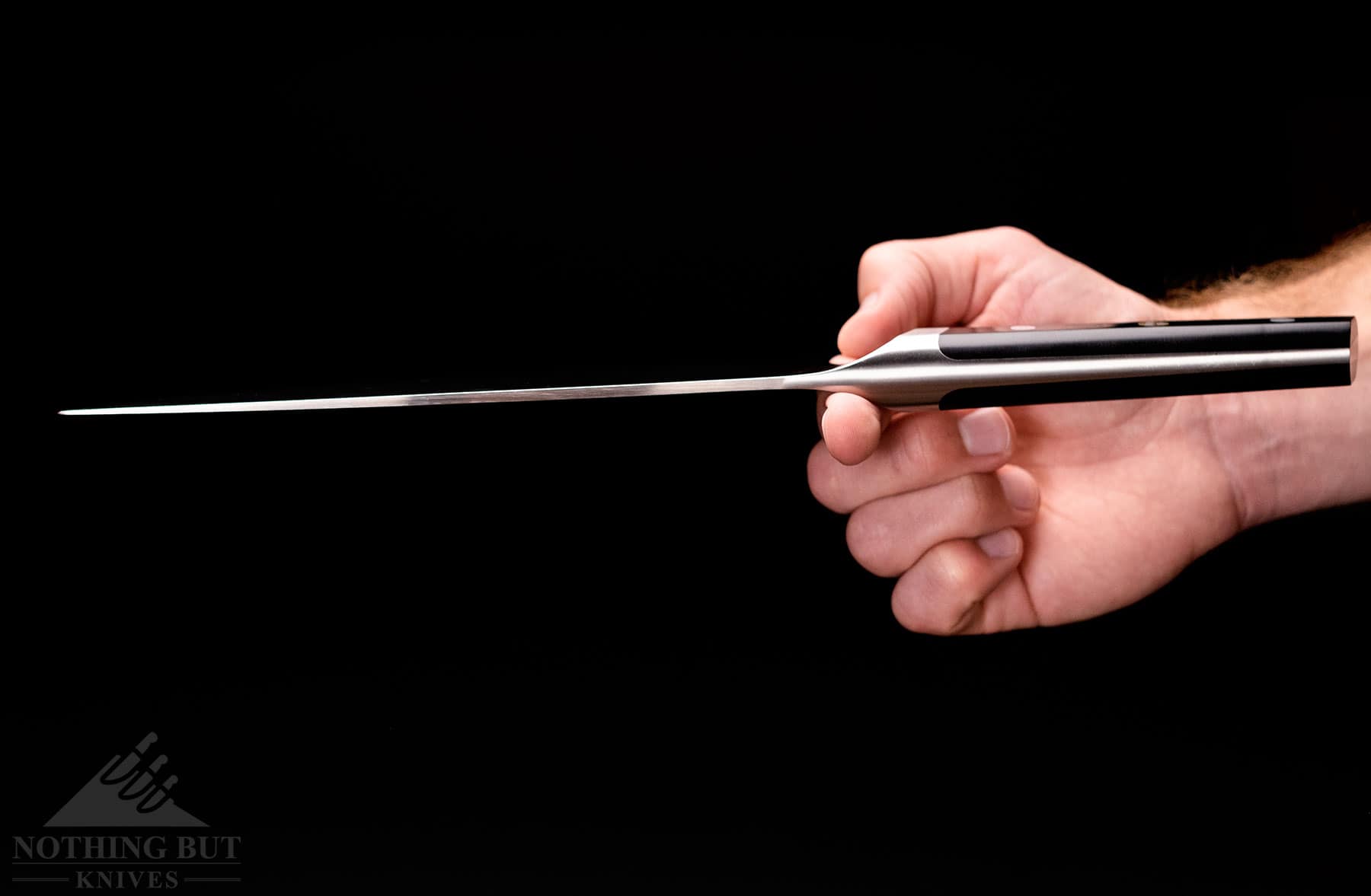
It looks like a lot of work went into getting the balance just right on this, and most of that work shows up in the tang. It took me longer than I care to admit to figure out what Cangshan meant when they said the TC chef’s knife has a “uniquely tapered tang”.
After staring dumbly at the front and back of this thing for a while I realized that the tang tapers from thick to thin on the back (starting from the bolster), and thin to thick on the front. In most western knives the tang is just a straight line going all the way through, and it’s also thinner overall in most cases.
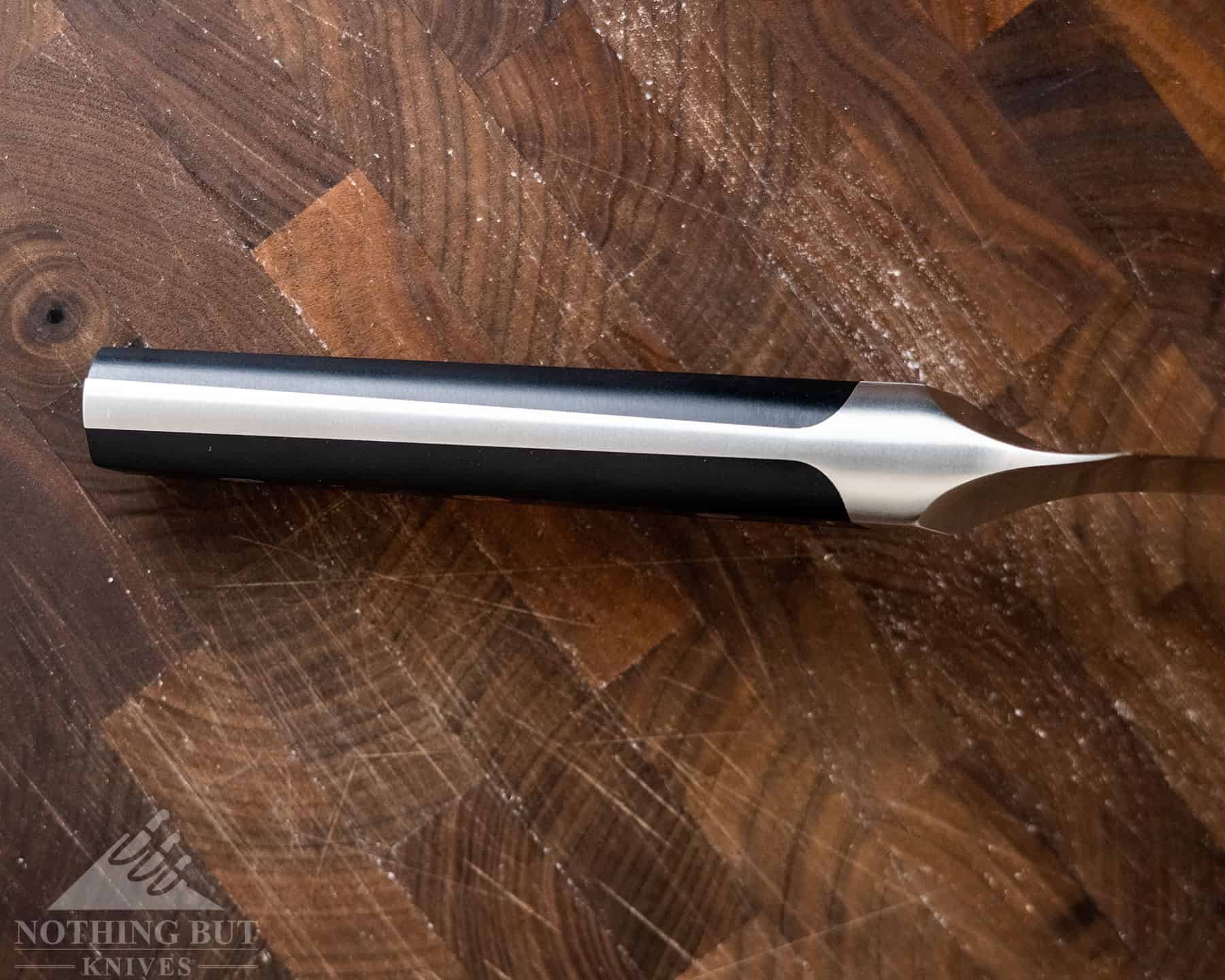
With this, the tang on the back is about 8 mm at the top then tapers all the way down to about 4 mm at the butt. On the front it starts at around 5 mm and thickens to 6 mm. Which also means that, front to back, the tang tapers from 6 to 4 mm along the butt and 5 to 8 mm just beneath the bolster.
So the piece of metal they stuck between the scales not only isn’t straight but has no side or corner that’s the same width as the other, making it this odd, wavy shape that I assume was created through a lot of trial and error in getting the balance they wanted.
Even with the tapering, all of that’s pretty thick, and it still leaves this knife heavier than average. But the weight distribution works out pretty well to put the bulk of that weight around the bolster. This makes it really easy to control the blade in a pinch grip, and makes the knife feel a lot more nimble in spite of the thick slab of wonky metal.
The Almost Octagon Handle
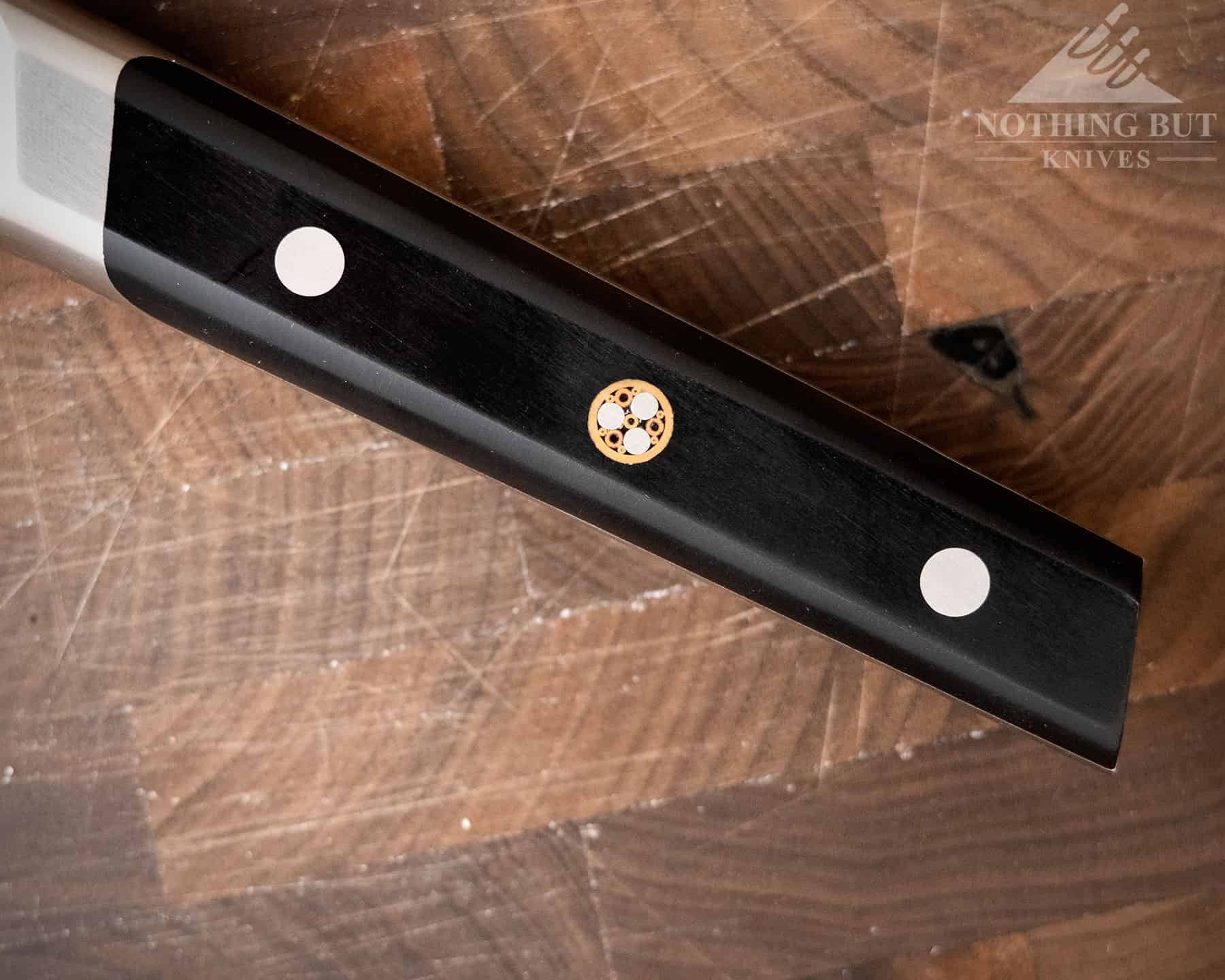
The slightly less interesting part of the handle is the mostly oval shape that’s so wide that it’s almost an octagon. It feels like a compromise between the two extreme styles. That’s not a unique element to this knife, but it’s not super common to see attached to a western blade.
Now, I could go a gassy tirade about how this semi-octagonal handle facilitates better cutting ergonomics for western style cooking because it provides a wider grip without interfering with maneuverability, or how it does the opposite because the handle has no belly and the way the overall width tapers toward the butt causes a slight cramping sensation.
All of those things apply to me, but I have to be careful about praising or criticizing handle shape when it comes to kitchen cutlery, because it’s ultimately a matter of personal need. Cangshan has obviously workshopped a lot of smaller details on this knife, and I’m not enough of a kitchen-knife expert to say with much certainty that this handle was a good idea.
I like the way it looks. I half like the way it feels.
It has a Long Neck
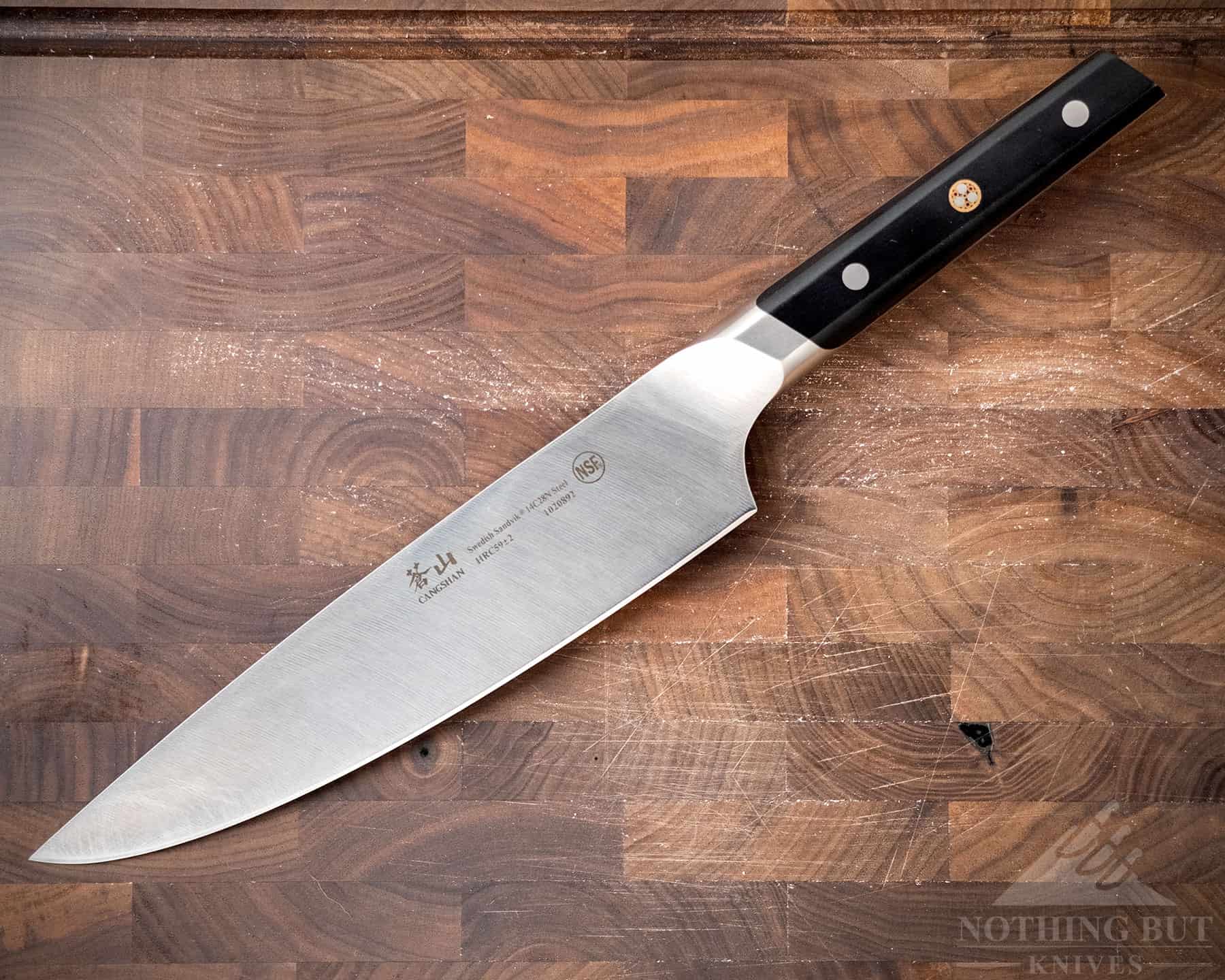
Another really important element to note here is how high above the tang the edge starts. This puts the edge solidly above your fingers if you hold a pinch grip right on the angled bolster, which, again, is something you tend to see more in Japanese knives. (It’s also worth keeping in mind that when people say the handle on this is 5 and a half inches, they’re including the bolster and everything else right beneath the start of the cutting edge. The length of the thick part of the handle with scales is closer to four and a half inches.)
Compare this to something like the Zwilling Pro or the Wusthof Classic, both of which put a pinch grip right on the heel of the blade behind the bottom of the cutting edge.
This will have an effect on the kind of leverage you can get with this knife, although whether it’s for better or worse depends on how you tend to cut, I think. For myself, I noticed it felt easier to cut with the top half of the blade, but it did feel like it got a little trickier to cut as I used lower parts of the blade.
Comparison and Alternatives
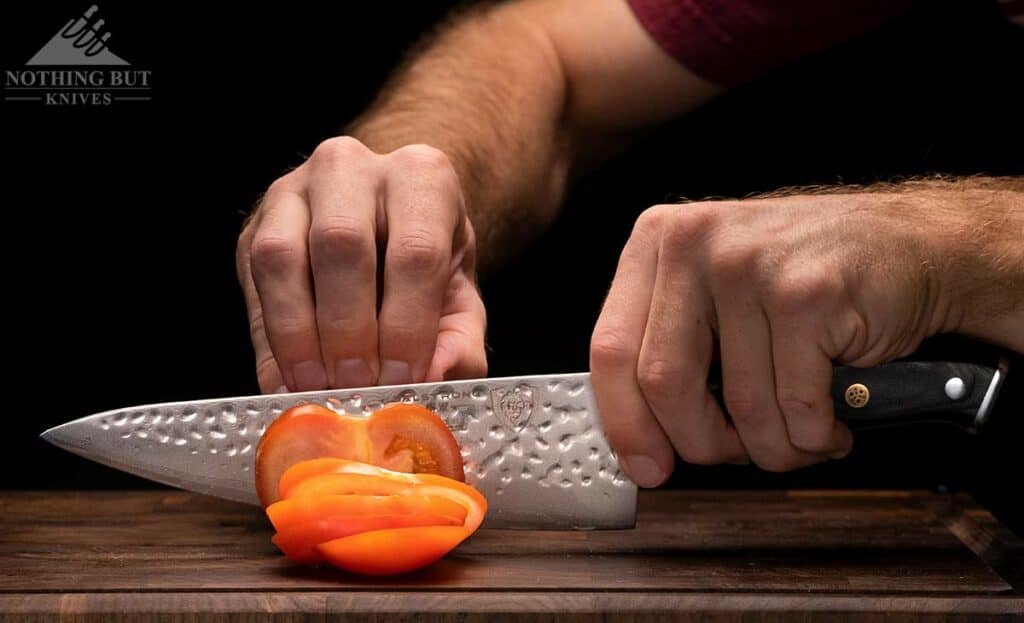
The alternatives in this price range (at least, the ones I can pul from personal experience) pretty much give you the option of leaning more toward comfort, looks, or performance.
For a similar blade and bolster profile on a slightly shorter (and lighter) knife, the Zwilling Pro is a more traditional western handle with roughly the same blade shape. I personally like the feel of the Zwilling Pro better, but it is a little more expensive and it’s using steel that is arguably a downgrade and hardened a step softer. (I reviewed the Zwilling Pro S, which has a full bolster, and I ultimately end up saying it’s good but get the regular Pro version with the half bolster).
I’d recommend the Misen chef knife for a similar handle. It’s shorter but still one of the more comfortable knives we’ve tested, and the steel is pretty solid as well. Just be prepared to sharpen the Misen up, because we were not impressed by the factory edge when we tested it. For what it’s worth, the Misen also runs about $20 cheaper most of the time.
Now if you’re here because you’re looking for a good knife with some kind of Asian styling I could point you toward the Dalstrong Shogun X. It’s heavily styled, and probably a little more expensive than it should be, but it runs in the same vein of fusing Western and Japanese elements in the construction. I think the Cangshan TC’s overall make was executed a little better, but it doesn’t bite or cut as cleanly right out of the box.
Does It Belong in Your Kitchen?
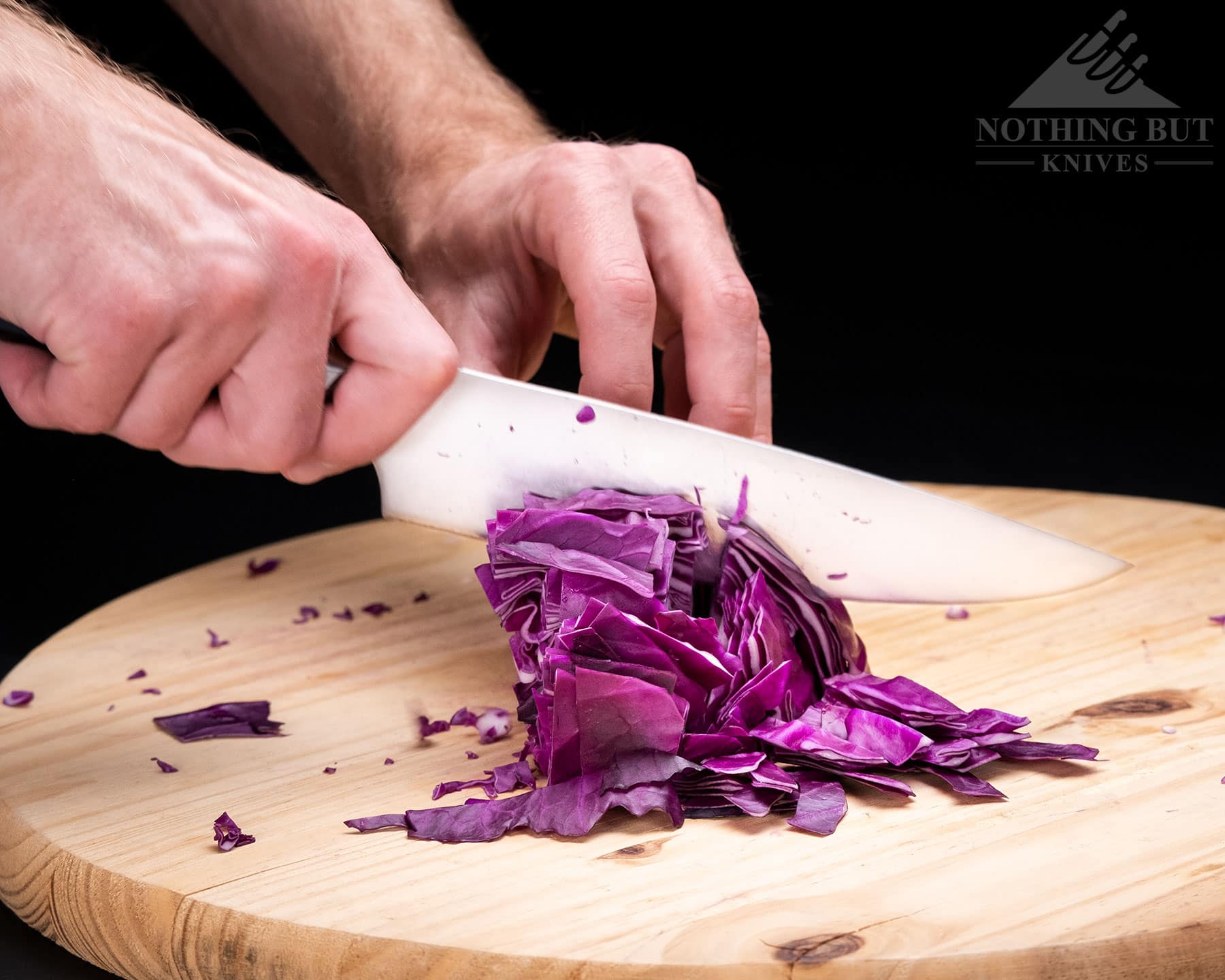
I think what I appreciate the most about the Cangshan TC chef’s knife is that it’s a western style blade with a handle that you don’t get on many western chef’s knives. With a world of decent options in the kitchen knife world with very little variation, it’s nice as a reviewer to see things like this. The wild variation in the tang is also interesting from an enthusiast’s perspective, and it turns out to have a good, functional outcome with the balance and weight.
As someone who cooks a lot, I can’t say I’m personally a fan of how it feels. But I’ve gotten used to thinner oval handles over the years. That’s where my bias lies now. It’s possible that this chef knife will feel more comfortable in the hands of a larger-handed cook.
Whatever my own preferences are, though, Cangshan has made a fairly affordable chef’s knife that performs well and looks good. So in that sense I have no trouble saying this knife is worth getting if you’re in the market for a mid-range Western kitchen knife that’s a little different from the others.

Hello,
My friend gave me a set of these for my birthday. I have never had a knife rust faster. As a matter of fact, I have never had a knife rust. I contacted the company and they told me it was my fault for leaving the blade wet for too long. I’m like really… they are only a week old.
Sharp as all get out, but they should not be rusting. I’m disappointed but don’t want to downplay them to my friends as they were a gift.
Hey Terri. That sucks to hear. We haven’t had that problem yet. It normally takes a lot for the kind of steel in these knives to start rusting, but it’s possible they had a batch with a bad heat treatment.